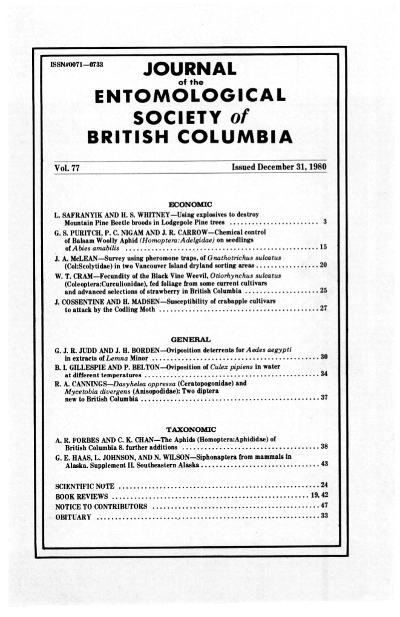Using explosives to destroy mountain pine beetle broods in lodgepole pine trees
Abstract
The effectiveness of explosives for the destruction of mountain pine beetles in individual lodgepole pine trees was investigated. Two types of detonating cord, and various placements, were tested on infested bolts and trees, and a plastic explosive was tested on bolts. Explosives killed broods directly, and indirectly by habitat disruption. Direct effects extended about 9 cm from the explosion and mortality was inversely related to distance. Indirect effects via extensive loosening and shedding of bark caused far greater mortality than direct effects. On trees, summer and fall treatment was much more effective than spring treatment, regardless of cord placement. Fall treatment using 10 g/m detonating cord helically wrapped onto the boles at 10, 20 and 30 cm spacings caused 100%, 98% and 70% mortality of broods respectively. Generally, vertical placement of the cord into grooves cut through the bark caused more bark disruption and therefore, more brood destruction than did helically wrapped cord placed on the surface.References
Berryman, A.A. 1979. A synoptic model of lodgepole pine/mountain pine beetle interaction and its potential application in forest management. In: Theory and Practice of Mountain Pine Beetle Management in Lodgepole Pine Forests. Symposium Proceedings, April 25-27, 1978. Forest, Wildlife and Range Experiment Station, University of Idaho, Moscow.
Cochran, W.G. 1954. Some methods for strengthening the common X2 tests. Biometrics 10:417-451.
Evenden, J.C., W.D. Bedard, and G.R. Struble. 1943. The mountain pine beetle, an important enemy of western pines. U.S.D.A. Circ. 664.
Frings, H. and M. Frings. 1967. Behavioral manipulation (Visual, mechanical and acoustical). In: Pest Control, Biological, Physical and Selected Chemical Methods. W. W. Kilgore and R. L. Doutt, Eds. Academic Press, NY. 477 pp.
Gray, B. and J. Buchter. 1969. Termite eradication in Araucaria plantations in New Guinea. Comm. For. Rev. 48:201-207.
Kara, V. 1974. Injuries to Colonies from explosion (Apis mellifera). Vcelarstvi 27:198.
Klein, W.H. 1979. Strategies and tactics for reducing losses in lodgepole pine to the mountain pine beetle by chemical and mechanical means. In: Theory and practice of Mountain Pine Beetle Management in Lodgepole Pine Forests. Symposium Proceedings, April 25-27, 1978. Forest, Wildlife and Range Experiment Station, University of Idaho, Moscow.
Kuroki, T. and K. Kumanda. 1961. The effects of underwater explosions for the purpose of killing predacious fishes. Bull. Fac. Fish. Hokkaido Univ. 12:16-31.
Quayle, D.B. 1942. The use of dynamite in teredo control. Can. Fisheries Research Board. Progr. Rept. Pacific Coast Stations. No. 51.
Reid, R.W., H.S. Whitney, and J.A. Watson. 1967. Reactions of lodgepole pine to attack by Dendroctonus ponderosae Hopkins and blue stain fungi. Can. J. Bot. 45: 1115-1126.
Taylor, A.R. 1973. Ecological aspects of lightning in forests. Proc. Ann. Tall Timbers Fire Ecol. Conf., Mar. 22-23, Tallahassee, Florida.
Whitney, H.S., L. Safranyik, S.J. Muraro and E.D.A. Dyer. 1979. In defence of the concept of direct control of mountain pine beetle populations in lodgepole pine: Some modern approaches. In: Theory and Practice of Mountain Pine Beetle Management in Lodgepole Pine Forests. Symposium Proceedings, April 25-27, 1978. Forest, Wildlife and Range Experiment Station, University of Idaho, Moscow.
Downloads
Published
Issue
Section
License
Authors who publish with the Journal of the Entomological Society of British Columbia agree to the following terms:
-Authors retain copyright and grant the journal right of first publication with the work simultaneously licensed under a Creative Commons Attribution License that allows others to share the work with an acknowledgement of the work's authorship and initial publication in this journal.
-Authors are able to enter into separate, additional contractual arrangements for the non-exclusive distribution of the journal's published version of the work (e.g., post it to an institutional repository or publish it in a book), with an acknowledgement of its initial publication in this journal.
-Authors are permitted and encouraged to post their work online (e.g., in institutional repositories or on their website) prior to and during the submission process, as it can lead to productive exchanges, as well as earlier and greater citation of published work (See The Effect of Open Access).


